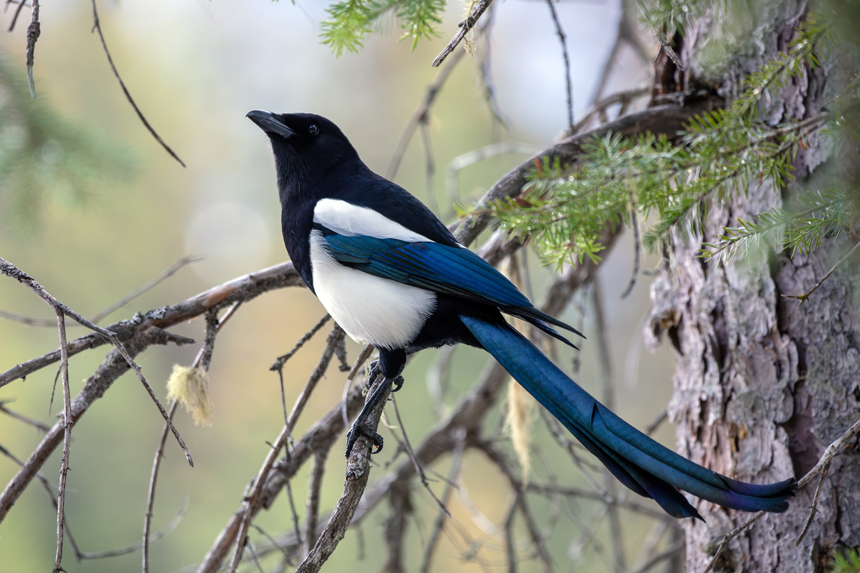Senior managing editor and logophile Andy Hollandbeck reveals the sometimes surprising roots of common English words and phrases. Remember: Etymology tells us where a word comes from, but not what it means today.
Not long ago, I had the opportunity to cruise through the beautiful, mountainous lands east of Salt Lake City. I pulled into a roadside rest stop and got out to stretch my legs and take a longer gander at the beautiful landscape. While I was taking in the scenery, I was startled when a bird I hadn’t noticed took flight near me.
I only got a glimpse of it, but my first impression was of a piebald crow with a skinny tail. I thought it might be a magpie, but I’m no ornithologist.
Farther down the road, in Evanston, Wyoming, I had a moment to consult the internet, and I learned two things: 1) It was, indeed, a magpie (a black-billed magpie, to be specific); and 2) By registering its coloring as piebald, I was actually invoking on the linguistic legacy of the magpie itself.
See, the pie in piebald is the same pie that’s in magpie.
Before the 1500s, the magpie was simply called pie, from the Old French name of the bird, which traces back to the Latin pica “magpie,” the feminine form of picus “woodpecker.”
Magpies — or pies — have long been known for three characteristics: First, they will eat almost anything. The former characteristic is how the word pica — again, the Latin word for “magpie” — came to be used in modern medical contexts as the name for an abnormal desire to eat non-food items.
Second is their stark black-and-white coloring. References to this coloring were common enough that the word pied came to describe anything having two (or even more) colors that appeared in blotches. It’s used often in the animal world, and especially among birds. Just a few examples: The bontebok, also called the pied antelope; the extinct Labrador duck, also referred to as a pied duck; there are pied flycatchers, finches, starlings, wagtails, widgeons, and woodpeckers, as well as the pied-winged coot. And, of course, there’s the Pied Piper of Hamelin, who was so-called because he wore a multicolored coat. These all, etymologically, point back to the old name for the magpie.
Third, these birds are noisy. They like to chatter, and they can actually be taught to talk. It’s this last characteristic that led pie to become magpie.
The name Margaret collapses into a slew of nicknames, including Marge, Madge, Maggie, and, somehow, Peg and Peggy. Mag was also one of these nicknames, though it was more common half a millennium ago than it is now.
The name Mag was used in slang and stories to indicate qualities generally associated with women (in a totally sexist way). One of those supposed female characteristics was the tendency toward idle chattering. A group of women talking about, well, anything really, might be summarily dismissed as a bunch of Mags. But at the same time, they might also be called a flock of chattering pies, equating their gossiping with the noises of the birds in the same way one might (but shouldn’t) refer to a group of women as a bunch of clucking hens.
So there was an overlap in the colloquial usage of mag and pie, and over time, the words converged, too. Both the birds and the vocal women were called magpies.
That covers magpie and the pie slice of the word piebald, but I promised you some baldness as well.
The bald part of piebald comes not from today’s more common sense of “lacking hair where hair normally grows” but from an older, broader sense of “marked with white.” (Does bald eagle make more sense now?) So the word piebald is a direct reference to the coloring of a magpie (the pie part) and the color white (the bald part).
Though piebald is often used to describe coloring consisting of irregular spots of white and another color (or, metaphorically, to something composed of incongruous parts), the word is properly used only to describe blotchy black-and-white coloring. An animal that has patches of white and another color (especially brown) is properly skewbald, which is a great Scrabble word.
Lastly: It’s possible, but not likely, that the pie that is eaten — whether it’s filled with a mixture of meat or fruits — is related to magpie, from the connection of the bird’s indiscriminate diet and the combining of multiple foods in a hot pastry crust. This type of pie traces back to Middle English, and its history before that is unclear.
Become a Saturday Evening Post member and enjoy unlimited access. Subscribe now




Comments
Andy, that opening photo is as beautiful as this feature is fascinating. I can’t help thinking that maybe these birds were probably busted centuries ago, for eating freshly baked pies put out on a ledge in front of the open kitchen window to cool. It can probably still a problem to this day, I would think, but couldn’t prove it.
I appreciate your dissection of the word here, with the not surprising Latin and French connection origins. As far as the nicknames for Margaret go, I don’t get Peg*, though it does have a ‘g’. Madge either because of the ‘d’. That’s English for you, of course.
*A favorite/fun Steely Dan song from the ‘Aja’ album.